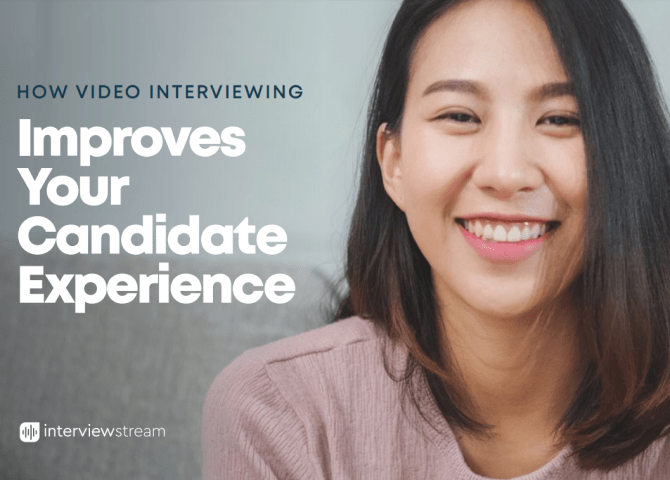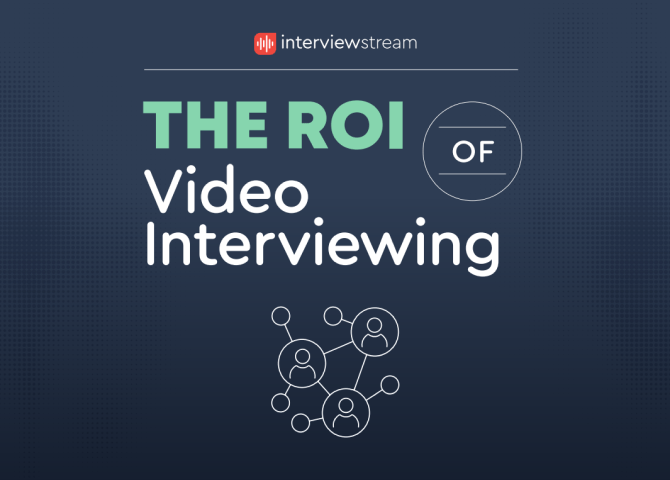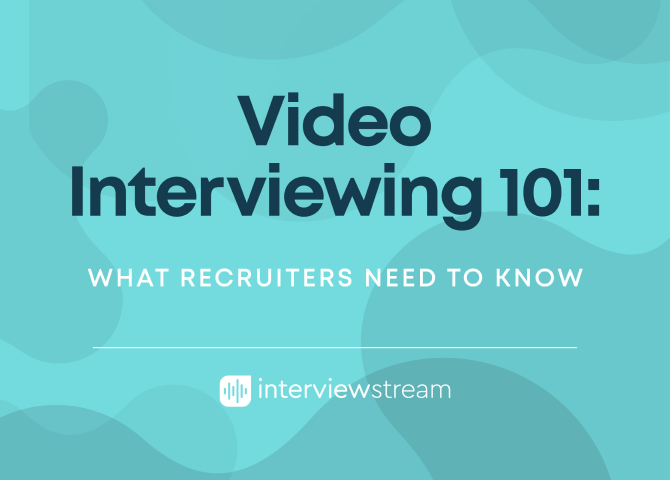Mastering AI-Powered Hiring: Strategies and Tools for Success

Artificial intelligence has been making headlines recently – promising to optimize recruiting workloads, write job descriptions, and find the best applicants for open positions. However, it’s crucial to understand AI’s capabilities and limitations.
AI can revolutionize talent acquisition, making it more efficient, effective, and fair. If you evaluate AI tools critically, you can avoid both bias and missing out on qualified candidates.
Interested in our HR newsletter? Sign up below!
Sign up for our newsletter – we send out a newsletter email two to four times a year which includes HR trends, industry-relevant knowledge, and the latest interviewing tips for recruiters and candidates.
What *is* Artificial Intelligence?
Artificial Intelligence (AI)
is the most general term for a variety of tools such as Intelligent Automation (IA) and Machine Learning (ML). People combine AI tools with other techniques to create useful or interesting AI systems.
Intelligent Automation (IA) combines Robotic Process Automation (RPA) tools with AI techniques to create systems that perform complex tasks without direct human supervision.
Machine Learning (ML) applications create models they use to solve problems or generate content without pre-programmed rules. They “learn” how to produce better results or react to unexpected situations by improving their models, often with human help, without new programming. People combine ML with data mining, statistical modeling, and other techniques to create forms of AI that perform complex analyses such as process optimization and predictive analytics.
Natural Language Processing (NLP) applications can understand and generate human language. NLP includes exciting new generative AI and conversational AI tools such as ChatGPT and DALL-E as well as familiar tools like chatbots. You can talk with an NLP application naturally, as if to another person, instead of learning prescribed commands.
Benefits of AI in Recruiting
AI in recruiting can help HR leaders reduce time-to-hire, improve hiring effectiveness, and ensure a fair hiring process.
How AI Improves Time-to-Hire
Companies that quickly extend offers to their top candidates have an advantage over those with slower hiring processes. Using AI tools to supplement human expertise helps diagnose weak points in the hiring process. After identifying the problem areas, HR experts can adopt different AI tools to make improvements.
Hiring Effectiveness and AI
Emerging AI tools can compare hiring materials and interview questions to subsequent performance post-hire to see whether the interviewing process identified employees who go on to perform well in their position.
There is a subtle but important difference between using predictive analytics to assess and improve the hiring process and using it to compare candidates to a profile derived from characteristics of existing employees. Using this kind of comparison risks perpetuating unconscious or institutional bias by favoring candidates who share demographic characteristics with current employees. It’s important to avoid using demographics–especially legally protected characteristics–in the analysis. Hiring managers just also balance analytics results with other information about the candidates.
Rather than comparing candidates to a “successful employee” profile, use analytics to examine the selection process, hiring materials, and interview questions and responses. That analysis might reveal which information about a candidate correlates with their later success. Then you can design your process to quickly and efficiently elicit that information and distinguish the candidates who truly possess the qualities to succeed in your organization.
Can AI Improve Fairness in the Hiring Process?
AI-driven tools can identify and uncover hidden biases in your process by:
- Analyzing data around interview questions
- Evaluating reviewer ratings and comments
- Interpreting your company’s data on candidate demographics and hiring decisions.
- Studying how a specific individual has rated all the candidates they’ve interviewed and how different interviewers rated the same candidate.
Along with candidate and interviewer demographics, this analysis can reveal opportunities for staff training or other adjustments to improve fairness. Having a structured interview process (a process that is the same for all recruiters and all candidates) also improves fairness in hiring.
Fairness and AI
In practice, these core values should make their way into your approach to branding, engineering, sales, customer service, employee development, recruiting—and anything and everything you do in between.
Culture-conscious companies build these values into their employee handbooks, performance reviews, interviews, and more. Your values should be made visible in every nook and cranny of your business. If they are hard to spot in anything you’re doing, you probably shouldn’t be doing it.
Challenges of AI in Recruiting
As useful as they can be, AI hiring tools also present challenges. These shouldn’t prevent adoption but do need to be carefully considered. Among these challenges are:
Hiring with AI Risks Diminishing the Human Touch
AI cannot replace the human touch in hiring. AI tools that interrupt the recruiter-candidate relationship can discourage top candidates. Recruiters should balance the use of AI with human involvement in the recruiting process.
Data Quality and Bias
AI models require large amounts of data to be trained effectively, and the quality of the data used can affect the accuracy of the model. If the data used to train an AI model is incomplete, outdated, or biased, the model may not perform as expected.
Similarly, AI systems can lead to discrimination in the hiring process if they are trained on biased data or algorithms. For example, an AI model might be more likely to recommend male candidates over female candidates, or candidates from certain ethnic backgrounds over others. This bias might not be intentional, but might result from relying on a system that embodies bias implicit in the data on which the AI model was trained. This can result in a lack of diversity in the workforce.
Lack of Transparency
AI systems can be opaque, making it difficult for recruiters to understand how the system is making recommendations or decisions. This lack of transparency can make it difficult to identify and correct and adjust for errors or biases in the algorithms used to make decisions through AI.
Legal Compliance
Using AI in recruiting must comply with various legal regulations such as data privacy laws, anti-discrimination laws, and labor laws. Employers must be careful to ensure that their use of AI in recruiting does not violate any of these regulations.
How to Use AI Tools in the Hiring Process
Use AI To Source Applicants
AI tools can efficiently search social media, professional networks, databases, and other sources to gather a larger or more focused pool of potential candidates. Generative AI can also aid in crafting job ads and position descriptions that attract more highly qualified applicants and enhance communication to improve the company’s image.
These tools provide deceptively credible results most of the time. However, recruiters need to use these tools with care. It’s important to form your own understanding of what skills and experience the ideal candidates must have and how to attract those individuals.
Generative AI can help you create polished, professional communications that appeal to the best candidates. They can’t replace your judgment about whom to attract.
AI-Powered Resume Screening and Candidate Matching
There are two main ways AI tools try to help recruiters who have to process dozens or even hundreds of resumes per open position:
- Surface resumes of more-qualified candidates while screening out less-qualified candidates
- Identify resumes of candidates most likely to succeed, if hired, as measured by criteria like performance reviews, hiring manager satisfaction, and longevity.
Semantic screening tools try to avoid the pitfalls of keyword-based screening by using AI to compare resumes to the criteria for a position. AI screeners might be better at recognizing more-qualified candidates whose resumes wouldn’t have passed an automated keyword check while screening out less-qualified applicants who are better at keyword tactics.
However, it’s important to understand how the AI screener is making its determinations. In addition, these tools share some drawbacks with keyword-matching tools such as preventing recruiters from applying their own experience, judgment, and insight to the screening process.
Screening tools based on predictive analytics claim to be able to suggest which candidates will be more successful if hired. For example, they might compare candidate resumes to resumes of successful employees. They can also take into account additional employee information your organization might have collected in its HRIS system or elsewhere.
Predictive analytics approaches risk perpetuating any bias, however unconscious or unintentional, might have been present either in past decisions to hire or in the performance, hiring manager satisfaction, or longevity of past hires. They also can’t account for ‘unseen’ metrics like affinity to company culture, soft skills, or personality.
AI-Supported Interviewing
With a strong pool of candidates, the interview process can move quickly from phone or video screening to in-depth interviews. AI tools can help do this efficiently. Tools like interviewstream’s AI Interview Question Authoring can suggest questions that reveal differences among similarly qualified candidates.
To be effective, recruiters need to both understand how to create prompts that generate useful results and how to evaluate those results. As with other AI tools, recruiters need to continue to rely on their own judgment and expertise to decide what to ask, and when.
Automated scheduling tools simplify the complex task of scheduling multiple candidates’ interviews on multiple interviewers’ calendars. Process monitoring tools can alert you to cancellations, unaccepted invitations, or lagging process stages so that you can act quickly to get things back on track.
When used to reduce administrative burdens, automated scheduling can free up time that you can then use to build stronger relationships with candidates and hiring teams. Closer relationships support better conversations about hiring criteria, responsibilities in the process, how to interview effectively and fairly, and so on.
AI-Assisted Candidate Engagement
When AI tools handle administrative tasks, recruiters have more time to build deeper candidate relationships. Scheduling interviews, screening resumes, and using on demand video interviews to screen candidates help free up recruiters’ time for more meaningful conversations throughout the process.
AI-assisted candidate communications such as conversational AI tools like chatbots also help candidates remain engaged by providing timely, relevant, and actionable information. These tools must be used with care and a degree of transparency, though, to avoid discouraging desirable candidates. HR leaders should consider whether their use of AI and automation enhances or avoids creating a positive candidate experience.
Ethical Considerations of Using AI for Hiring
Some ethical concerns arise with the use of AI tools in hiring. These can perpetuate bias, violate candidates’ privacy, reduce diversity, and dehumanize the hiring process. These include:
- Lack of human interaction and judgment
- Biased language and criteria that unfairly exclude certain candidates
- Lack of transparency and accountability in AI decision-making
- Inappropriate use of personal data
- Lack of diversity in training data
To address these concerns, carefully select the AI tools you use. Monitor and evaluate them regularly to ensure fairness, accuracy, and transparency in the hiring process. To help combat these ethical concerns, recruiters can:
- Create human touches in the application process (for example: a video introduction to an on demand video interview)
- Ensure a diverse group creates the interview questions and revises the training data when using AI
- Ask for feedback from a wide range of people to promote transparency
- Follow privacy laws to protect candidates’ personal data and support privacy
Best Practices for AI Recruiting
To use AI tools safely and effectively, companies should:
- Ensure transparency
- Use unbiased data
- Regularly audit and monitor AI algorithms
- Comply with privacy laws
- Involve humans in decision-making
- Provide clear communication to job candidates
- Continuously educate and train employees
Companies should also communicate clearly with job candidates about their use of AI tools and continuously educate and train their employees on the safe and effective use of these tools.
Want to learn more about video interviewing & scheduling?
Chat with a client success expert today and learn how to leverage remote interviewing solutions to show off the company culture at your organization.
Summary & The Future of AI in Recruiting
AI’s future in recruiting is clear and though somewhat unpredictable on the “how”, AI is already changing the industry rapidly. Generative and multimodal AI will have a profound impact on our lives, likely faster than we can imagine. That said, we can expect continued advances in all the areas discussed above and creative uses that have yet to be imagined.
Predictive analytics will target candidate effectiveness/hiring success by correlating employee performance and longevity with pre-hire candidate characteristics. However, this approach carries a risk of bias as it relies on current employee biases and may not address systemic and structural biases in diverse environments.
Text-to-video tools will benefit candidate sourcing and communication, allowing talent acquisition teams to create professional-quality videos from scripted company information and interview instructions. These AI video generation tools can use standard faces or a photograph of a spokesperson, saving time, equipment, and expense compared to traditional video production.
Sentiment analysis can assess a candidate’s interest in a position and an interviewer’s effectiveness using video, audio, and text processing to analyze facial expressions, tone of voice, word choice, and behavior. However, accuracy issues may arise for neurodivergent individuals, people from different cultural backgrounds, people with different physical or vocal characteristics, or those with varying temperaments.
Assessing candidates for their ability to use and understand AI tools will become more important. Candidates will need to possess AI-related qualifications for almost every role, including the ability to effectively use and understand AI tools while acknowledging their limitations, capabilities, and risks.
AI will enable candidate empowerment, allowing them to find and target desirable companies with ease. They can also use AI to create resumes and cover letters, leading to a shift in screening and evaluation methods. This trend is already apparent in education, where written work is being replaced by real-time demonstrations of skills and knowledge. Companies may need to become more selective at the top of the applicant funnel and more intentional in later rounds of hiring.
New tools that foster fairness could mask an applicant’s identity during early hiring rounds. One ATS system already gives recruiters the option of hiding an applicant’s name and other identifying information in an effort to increase fairness. AI audio and video generation could extend this concept to automated video interviews, with the possible effect of increasing diversity among the finalists. However, this approach has its own issues as it might homogenize superficial characteristics and create a bias toward a single “norm.” To address this, a range of “norms” could be used randomly for different positions.
It’s nearly impossible to know what lies ahead for AI in general and its use in hiring specifically. The technology itself as well as the way we interact with and the judgments we make about it are all changing rapidly, seemingly by the day. Will AI enable people and organizations to save time and money that will then be used to build and deepen relationships between people? Are we creating, as some caution, a future in which we each interact primarily with machines and less with each other, and suffer from that depersonalization? The arc of mobile phone adoption progressed from fears that mobile phones would destroy relationships to embracing them as tools that foster connection. Will our relationship to AI follow a similar trajectory?
While we can’t know the future, we can know what we value as organizations and as individuals. We can choose what technologies to use in recruiting and hiring. We can decide how to exploit their power and mitigate their risks. And we can accept the responsibilities as well as the benefits that come with their use.
Conclusion
Artificial Intelligence in recruiting will transform the hiring process in the coming years. AI recruitment tools can source candidates, improve candidate matching, speed up resume screening, and enhance candidate engagement. However, AI tools also pose practical and ethical challenges that we need to ensure are being met before deploying these tools without consideration of the consequences.
Rewards can include greater efficiency, shorter hiring cycles, relief from administrative burdens, and creating better matches between employers and hirees. Adopting AI-enabled systems can create opportunities for talent acquisition professionals to make better use of the knowledge and experience and to foster relationships with both candidates and hiring managers. On the other hand, over-reliance on AI technology can alienate desirable candidates, perpetuate bias (however unintentionally), and create the illusion of hiring effectiveness without actually improving quality of hire.
HR leaders need to ensure the tools they adopt align with their organization’s goals for process optimization, hiring effectiveness, and fairness. AI hiring tools, like other AI applications, are likely to change and improve rapidly, with tomorrow’s tools offering capabilities we might not even imagine today. In addition, our understanding and perception of, and relationship to, this technology will also evolve. It’s an exciting time that can reward HR pros who embrace the opportunity AI in hiring offers while aligning its power with their organizations’ real needs.
About interviewstream
interviewstream’s digital interviewing software helps you screen faster with one way video interviews and live video interviews, automates interview scheduling, and gives you deep data-driven insights to improve your interviewing process. We aim to make the job search and interviewing process easy for both candidates and recruiters by providing an intuitive and easy to use platform that adapts to your unique hiring needs. Talk to an expert today to learn how to get started.
About The Author
Faith Peterson is the Principal Product Manager at interviewstream. She’s devoted her career to making software better so that people can use it effectively and efficiently–and feel confident and capable doing so. Her focus on responsible and ethical tech informs her work in Product. She’s often found tending her native plant garden.
The interviewstream platform
Speak to an expert today to learn how our remote interviewing solutions make hiring more effective.
About interviewstream
interviewstream’s digital interviewing software helps you screen faster with one way video interviews and live video interviews, automates interview scheduling, and gives you deep data-driven insights to improve your interviewing process. We aim to make the job search and interviewing process easy for both candidates and recruiters by providing an intuitive and easy to use platform that adapts to your unique hiring needs.
Table of contents



